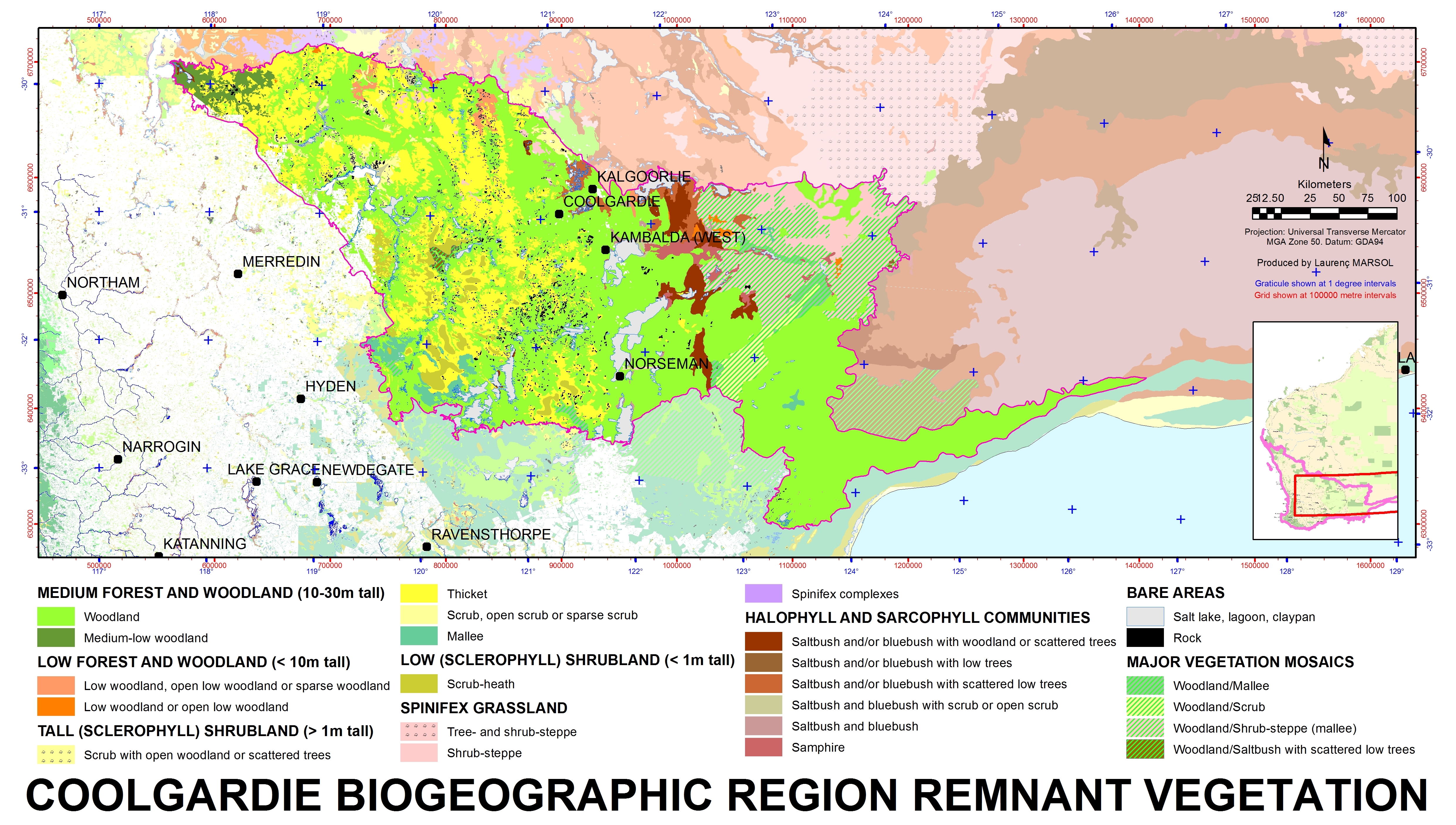Coolgardie (biogeographic Region) on:
[Wikipedia]
[Google]
[Amazon]
Coolgardie is an Australian bioregion consisting of an area of low hills and plains of infertile sandy soil in

Western Australia
Western Australia (WA) is the westernmost state of Australia. It is bounded by the Indian Ocean to the north and west, the Southern Ocean to the south, the Northern Territory to the north-east, and South Australia to the south-east. Western Aust ...
. It has an area of . It includes much of the Great Western Woodlands
The Great Western Woodlands is located in the southwest of Australia. The woodlands cover almost , a region larger in size than England and Wales. The boundary of the Great Western Woodlands runs from the Nullarbor Plain in the east to the West ...
.
Location and description
This is a transition zone between theMediterranean climate
A Mediterranean climate ( ), also called a dry summer climate, described by Köppen and Trewartha as ''Cs'', is a temperate climate type that occurs in the lower mid-latitudes (normally 30 to 44 north and south latitude). Such climates typic ...
of Australia
Australia, officially the Commonwealth of Australia, is a country comprising mainland Australia, the mainland of the Australia (continent), Australian continent, the island of Tasmania and list of islands of Australia, numerous smaller isl ...
's south-west coast and the country's dry interior. The poor soil makes it unsuitable for agriculture but Coolgardie has been a gold and nickel mining area.
It is bounded on the north by the arid Murchison bioregion, characterised by open Mulga woodlands and steppe. The low shrublands of the arid Nullarbor Plain lie to the east.
The Mallee bioregion adjoins Coolgardie on the south. The Avon Wheatbelt
The Avon Wheatbelt is a bioregion in Western Australia. It has an area of . It is considered part of the larger Southwest Australia savanna ecoregion.
Geography
The Avon Wheatbelt bioregion is mostly a gently undulating landscape with low rel ...
bioregion is to the west.
The Coolgardie bioregion, together with the coastal Hampton bioregion to the southeast, constitute the Coolgardie woodlands ecoregion
An ecoregion (ecological region) is an ecological and geographic area that exists on multiple different levels, defined by type, quality, and quantity of environmental resources. Ecoregions cover relatively large areas of land or water, and c ...
defined by the World Wildlife Fund.
Flora and fauna
The low hills are home to woodland ofendemic
Endemism is the state of a species being found only in a single defined geographic location, such as an island, state, nation, country or other defined zone; organisms that are indigenous to a place are not endemic to it if they are also foun ...
species of eucalyptus
''Eucalyptus'' () is a genus of more than 700 species of flowering plants in the family Myrtaceae. Most species of ''Eucalyptus'' are trees, often Mallee (habit), mallees, and a few are shrubs. Along with several other genera in the tribe Eucalyp ...
while the sand plains are covered in scrubland
Shrubland, scrubland, scrub, brush, or bush is a plant community characterized by vegetation dominance (ecology), dominated by shrubs, often also including grasses, herbaceous plant, herbs, and geophytes. Shrubland may either occur naturally o ...
. The areas nearer the west coast have more protea flowers while the drier inland is home to acacia
''Acacia'', commonly known as wattles or acacias, is a genus of about of shrubs and trees in the subfamily Mimosoideae of the pea family Fabaceae. Initially, it comprised a group of plant species native to Africa, South America, and Austral ...
trees and kwongan heathland.
Wildlife of the Coolgardie bioregion includes birds such as malleefowl, laughing kookaburra and barking owl, and reptiles such as the thorny devil and desert death adder. Mammals include the echidna, brushtail possum, red kangaroo, eastern wallaroo and bilby.
Vegetation

References
Further reading
* Thackway, R and I D Cresswell (1995) ''An interim biogeographic regionalisation for Australia : a framework for setting priorities in the National Reserves System Cooperative Program'' Version 4.0 Canberra : Australian Nature Conservation Agency, Reserve Systems Unit, 1995. {{coord missing, Western Australia Biogeography of Western Australia Coolgardie woodlands IBRA regions Mediterranean forests, woodlands, and scrub in Australia Southwest Australia